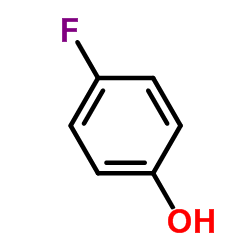4-氟苯酚

4-氟苯酚结构式

|
常用名 | 4-氟苯酚 | 英文名 | 4-Fluorophenol |
|---|---|---|---|---|
| CAS号 | 371-41-5 | 分子量 | 112.102 | |
| 密度 | 1.2±0.1 g/cm3 | 沸点 | 183.3±13.0 °C at 760 mmHg | |
| 分子式 | C6H5FO | 熔点 | 43-46 °C(lit.) | |
| MSDS | 中文版 美版 | 闪点 | 68.3±0.0 °C | |
| 符号 |

GHS07 |
信号词 | Warning |
|
Atmospheric pressure chemical ionization of fluorinated phenols in atmospheric pressure chemical ionization mass spectrometry, tandem mass spectrometry, and ion mobility spectrometry.
J. Am. Soc. Mass Spectrom. 10(11) , 1157-65, (1999) Atmospheric pressure chemical ionization (APCI)-mass spectrometry (MS) for fluorinated phenols (C6H5-xFxOH Where x = 0-5) in nitrogen with Cl- as the reagent ion yielded product ions of M Cl- through ion associations or (M-H)- through proton abstractions. Pro... |
|
|
Convenient QSAR model for predicting the complexation of structurally diverse compounds with β-cyclodextrins
Bioorg. Med. Chem. 17 , 896-904, (2009) This paper reports a QSAR study for predicting the complexation of a large and heterogeneous variety of substances (233 organic compounds) with beta-cyclodextrins (beta-CDs). Several different theoretical molecular descriptors, calculated solely from the mole... |
|
|
Cellular apoptosis and cytotoxicity of phenolic compounds: a quantitative structure-activity relationship study.
J. Med. Chem. 48 , 7234-42, (2005) In this comprehensive study on the caspase-mediated apoptosis-inducing effect of 51 substituted phenols in a murine leukemia cell line (L1210), we determined the concentrations needed to induce caspase activity by 50% (I50) and utilized these data to develop ... |
|
|
Synthesis and evaluation of 3-aryloxymethyl-1,2-dimethylindole-4,7-diones as mechanism-based inhibitors of NAD(P)H:quinone oxidoreductase 1 (NQO1) activity.
J. Med. Chem. 50 , 5780-9, (2007) NAD(P)H:quinone oxidoreductase 1 is a proposed target in pancreatic cancer. We describe the synthesis of a series of indolequinones, based on the 5- and 6-methoxy-1,2-dimethylindole-4,7-dione chromophores with a range of phenolic leaving groups at the (indol-... |
|
|
The many roles for fluorine in medicinal chemistry.
J. Med. Chem. 51 , 4359-69, (2008)
|
|
|
Biotransformation of halophenols using crude cell extracts of Pseudomonas putida F6.
Appl. Microbiol. Biotechnol. 64(4) , 486-92, (2004) Crude cell extracts of Pseudomonas putida F6 transformed 4-substituted fluoro-, chloro-, bromo- and iodo-phenol without the exogenous addition of cofactors. The rate of substrate consumption decreased with increasing substituent size (F>Cl>Br>I). Biotransform... |
|
|
Isolation and properties of a pure bacterial strain capable of fluorobenzene degradation as sole carbon and energy source.
Environ. Microbiol. 7(2) , 294-8, (2005) A pure bacterial strain capable of aerobic biodegradation of fluorobenzene (FB) as the sole carbon and energy source was isolated by selective enrichment from sediments collected from a polluted site. 16S rRNA and fatty acid analyses support that strain F11 b... |
|
|
FT-IR and DFT studies of the proton affinity of small aminal cages.
Spectrochim. Acta. A. Mol. Biomol. Spectrosc. 74(2) , 588-90, (2009) The proton affinity scale of small aminal cages was investigated using experimental and theoretical methodologies. The formation constant (K(f)) was determined for 1:1 hydrogen-bonded complexes between p-fluorophenol (PFP) and some aminal cage type (B) in CCl... |
|
|
Synthesis of no-carrier-added 4-[18F]fluorophenol from 4-benzyloxyphenyl-(2-thienyl)iodonium bromide.
Molecules 16(9) , 7621-6, (2011) 4-[(18)F]Fluorophenol is a versatile synthon for the synthesis of more complex radiopharmaceuticals bearing a 4-[(18)F]fluorophenoxy moiety. In order to prepare 4-[(18)F]fluorophenol in no-carrier-added (n.c.a.) form only a nucleophilic labelling method start... |
|
|
Defluorination of 4-fluorophenol by cytochrome P450(BM₃)-F87G: activation by long chain fatty aldehydes.
Biotechnol. Lett. 34(9) , 1725-31, (2012) Cytochrome P450(BM3)-F87G catalyzed the oxidative defluorination of 4-fluorophenol, followed by reduction of the resulting benzoquinone to hydroquinone via the NADPH P450-reductase activity of the enzyme. The k (cat) and K (m) for this reaction were 71 ± 5 mi... |